
NPS photo Amanda Murphy The American Southwest is well-known for the quantity and diversity of the reptiles and amphibians, and El Malpais is no exception. Whether you walk down a trail or bushwack into the backcountry, you never know what you will see scurrying along in a grassy meadow, hiding on the other side of a clinker of a'a lava, or slithering along in a fold a pahoehoe flow. | |
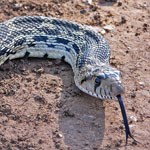
NPS photo Amanda Murphy BullsnakeThe bullsnake (Pituophis catenifer sayi) is one of the largest snakes native to North America, growing up to 8 feet (2.4 meters) long. Often confused with rattlesnakes, bullsnakes lack a rattle. However, bullsnakes mimic rattlesnakes in coloration and dorsal, or back, pattern. They can also shake its tail and re-create a rattle-like sound with its hiss, further encouraging potential predators to leave it alone. 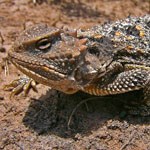
NPS photo Amanda Murphy Horned LizardMore commonly referred to as "horned toads" or "horny toads,", horned lizards are fully reptilian. Approximately five different species live in the El Malpais region, but a unifier between them is their method of self-defense. When a horned lizard feels threatened, it can inflate its body to twice their normal size, which makes them much harder to predators to bite or swallow. A few species can shoot a stream of blood from the corner of their eyes when attacked. This method causes enough confusion in predators for the horned lizard to make its escape. 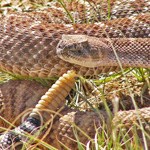
NPS photo Amanda Murphy Western Diamondback RattlesnakeAn icon of the American southwest, western diamondback rattlesnakes (Crotalus atrox) are one of the venomous species of snake at El Malpais. Diamondbacks will often spend daytime hours coiled in the shade of fallen trees, rocks or low growing shrubs. During summer months, diamondbacks are most active in the mornings and evenings, hunting for rodents. |
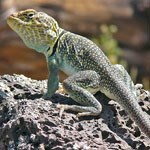
NPS photo Amanda Murphy Collared LizardsCommonly found in rocky areas, collared lizards (Crotaphytus collaris) bask in the sun warming their body and looking for prey. When defending their territory, males are known to bob their heads and do "push-ups." Both male and female collared lizards bear one to three solid black bands around their necks, appearing as solid collars. Males lizards are also brightly colored in yellows and blues, especially during mating season. Female collared lizards are more plainly colored, but gain red or orange bands between the ever-present black collars when preparing to lay eggs. 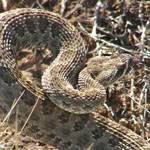
NPS photo Amanda Murphy Prairie RattlesnakePrairie rattlesnakes (Crotalus viridis) are one of the more timid species of rattlesnake, often evading a confrontation rather than coiling up and rattling. However, they may still rattle if they feel cornered. 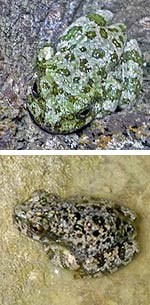
NPS photos Amanda Murphy, Dave Hays Canyon TreefrogThe canyon treefrog (Hyla arenicolor) is a small, rough-skinned frog with abrasive pads on the toes of all four feet for climbing. Despite the dry climate of the area, the canyon tree frog is a Colorado Plateau and Southwest native. Colors and patterns can vary from individual to individual. A canyon treefrog's tongue is attached to the front of its jaw and actually flips forward to catch insects. Canyon treefrogs rely on tinajas, temporary pockets of water in bedrock depressions, that fill with summer monsoon rains to lay their eggs. The laid eggs are then in a race against the tinaja evaporating to hatch into tadpoles, mature into froglets, and find a cooler environment as adults. |
Last updated: May 6, 2025
